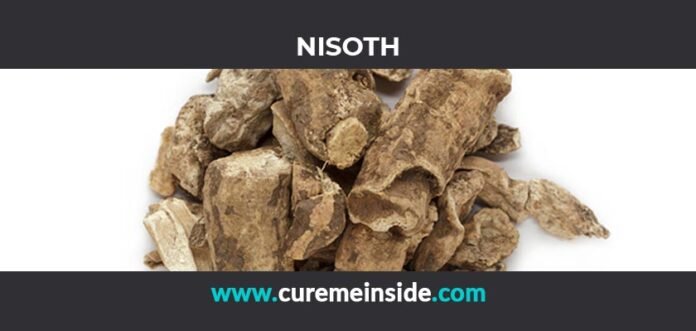Nisoth
Nisoth, also known as Indian jalap, is a medicinal herb with a number of health advantages.(HR/1)
The plant comes in two types (black and white), with the white variety’s dried roots being the more commonly used for therapeutic purposes. Nisoth, according to Ayurveda, is beneficial in the treatment of constipation. Because of its Rechna (laxative) properties, Nisoth churna facilitates bowel movements when eaten with warm water. Its powerful antibacterial properties also aid in the management of bacterial illnesses. Nisoth juice mixed with a glass of water and taken on an empty stomach every morning helps to manage fever by reducing body temperature due to its antipyretic properties.Because of its antiulcer effect, nisoth intake may help lower the risk of gastric ulcers, hyperacidity, and gastrointestinal tract disorders. If you’re taking Nisoth with another anti-diabetic medication, you should keep an eye on your blood sugar levels because it can cause an abrupt drop.
Nisoth is also known as :- Operculina turpethum, Syama, Tribandi, Teudi, Tvuri, Dhdhakalami, Terpeth Root, Indian Jalap, Kala Nasottara, Nishothra, Vili Tigade, Trikolpokanna, Nisottar, Dudholomo, Karum Sivadai, Tella, Tegada, Turbud, Nishotha.
Nisoth is obtained from :- Plant
Uses and benefits of Nisoth:-
As per several scientific studies, uses and benefits of Nisoth (Operculina turpethum) are mentioned as per below(HR/2)
- Constipation : Nisoth, according to Ayurveda, has a high Virechak (purgative) characteristic, which helps to increase bowel movement and evacuate stool more readily.
- Piles : Because of its Virechak (purgative) character, Nisoth provides relief from piles and related symptoms such as itching, burning, and swelling in the anus region.
- Obesity : Due to its Virechak (purgative) and detoxifying qualities, Nisoth exhibits good benefits in decreasing excess fat and swelling in the body by removing superfluous water and toxin from the body.
- Cough and Bronchitis : Because Nisoth has a Kapha balancing characteristic, it relieves respiratory disorders such as cough, bronchitis, asthma, and dyspnea caused by excess mucus.
- Worms : Nisoth’s Krimighna (Anti Worms) quality aids in the treatment of worm infestations in the intestine.
- Arthritis : Because of its Virechak (purgative) nature, this herb is effective in treating arthritis and reducing inflammation and swelling in joints.
Video Tutorial
Precautions to be taken while using Nisoth:-
As per several scientific studies, below precautions should to be taken while taking Nisoth (Operculina turpethum)(HR/3)
- Nisoth should be taken in recommended dose and duration. A high dose can cause diarrhea and other digestion related problems due to its purgative nature.
- Nisoth should not be used in children below 12 years.
- Nisoth should be avoided if someone has diarrhea and bleeding per rectum (bleeding from the anus).
- Nisoth has strong purgative property and should not be used if you have appendicitis.
Special precautions to be taken while taking Nisoth:-
As per several scientific studies, below special precautions should to be taken while taking Nisoth (Operculina turpethum)(HR/4)
- Breastfeeding : During nursing, Nisoth should be avoided.
- Pregnancy : During pregnancy, Nisoth should be avoided.
How to take Nisoth:-
As per several scientific studies, Nisoth (Operculina turpethum) can be taken into the methods mentioned as per below(HR/5)
- Nisoth churna : Take one fourth to half tesapoon Nisoth churna with warm water after lunch and also dinner. In situation of heaps, take Nisoth churna with Triphala churna.
- Nisoth Juice : Take one to two teaspoon Nisoth juice. Added with one glass of water. Take it in the morning vacant stomch once a day.
How much Nisoth should be taken:-
As per several scientific studies, Nisoth (Operculina turpethum) should be taken into the amounts mentioned as per below(HR/6)
- Nisoth Juice : One to two tesapoon once a day.
- Nisoth Churna : One fourth to half twice day.
Side effects of Nisoth:-
As per several scientific studies, below side effects need to be taken into consideration while taking Nisoth (Operculina turpethum)(HR/7)
- There is not enough scientific data available about side effects of this herb yet.
Questions asked frequently Related to the Nisoth:-
Question. What is the chemical constituent of Nisoth?
Answer. Glycosides resin, volatile oil, glucose, and fructose are all found in Nisoth and are used to cure a number of chronic ailments.
Question. What are the two varieties of Nisoth?
Answer. Nisoth comes in two different varieties: 1. The colour black (Krishna) 2. Shweta (white)
Question. Does Nisoth has antimicrobial activity?
Answer. According to studies, Nisoth’s possible antibacterial activity may lessen the risk of bacterial infection caused by Escherichia coli and Shigella dysenteriae by suppressing bacterial cell wall formation.
Question. Is Nisoth good for reducing fever?
Answer. Nisoth has antipyretic properties and inhibits the cyclooxygenase enzyme, which helps to lower fever. During a fever, inhibiting this enzyme reduces inflammation and pain.
Question. Is Nisoth good for liver?
Answer. According to studies, Nisoth possesses hepatoprotective properties and protects the liver from chemical damage.
Question. Can Nisoth reduce the risk of ulcer?
Answer. Nisoth has antiulcer properties and may help to lower the risk of gastric ulcers, hyperacidity, and other gastrointestinal issues.
Question. Is Nisoth safe for diabetic patients?
Answer. Nisoth may have a synergistic impact with anti-diabetic medications, lowering blood sugar levels. If you’re using Nisoth with anti-diabetic medication, it’s a good idea to keep an eye on your blood glucose levels.
Question. What are the health benefits of Nisoth?
Answer. Because of the inclusion of numerous elements, Nisoth offers a number of health benefits, including the ability to manage pain due to its analgesic properties. Because of its liver-protecting effect, the antioxidants in Nisoth protect the liver from free radical damage. Its analgesic, anti-inflammatory, and anti-arthritic qualities aid in the management of arthritis symptoms such as pain and inflammation. Because of their antibacterial properties, it helps to prevent a variety of infections. Nisoth also has a laxative effect, which aids in the smooth passage of faeces and reduces constipation. Due to its anti-venom properties, it is also effective in scorpion or snake stings.
Nisoth provides a number of health advantages. Due to its Ushna (hot) and Rechana (laxative) qualities, it aids in the management of specific disorders such as indigestion and constipation. These characteristics aid digestion by increasing hunger and encouraging bowel movements. Due to its Kashaya function, it is also used to treat specific skin disorders like as dryness or damaged skin.
Question. Can Nisoth help in treating oedema?
Answer. Yes, Nisoth may aid with oedema management because it has anti-inflammatory elements. It helps to manage oedema by lowering the levels of compounds (prostaglandins) in the body that cause swelling or oedema.
Oedema is a type of swelling that affects any area of the body and is caused by a Vata dosha imbalance. Nisoth’s Sothhar (anti-inflammatory) property aids in the management of oedema by reducing pain and inflammation.
Question. Does Nisoth helps in maintaining healthy cholesterol levels?
Answer. Yes, Nisoth aids in the maintenance of healthy cholesterol levels because it includes particular elements (flavonoids, saponins, and so on) that aid in the management of body fat and lipids. It raises the levels of good cholesterol (HDL) in the body while lowering the levels of bad cholesterol (LDL). It’s also possible that this reduces the risk of atherosclerosis (narrowing of arteries due to plaque buildup).
Cholesterol is a disorder that develops as a result of inefficient or absent digestion, resulting in the accumulation of toxins in the blood vessels in the form of Ama (toxin that lingers in the body owing to incomplete digestion). Nisoth’s Ushna (hot) property, which promotes excellent digestion, aids in the management of elevated cholesterol levels. Due to its Rechna (laxative) nature, this aids in the proper digestion of Ama and the elimination of toxins from the body by cleansing the bowels.
Question. Is Nisoth helpful in pneumonia?
Answer. There is insufficient scientific evidence to suggest Nisoth’s role in pneumonia.
Yes, Nisoth could help with pneumonia, which is caused by a Kapha dosha imbalance. This could cause mucus to build up and cause a blockage in the respiratory system or lungs. Nisoth’s Kapha balancing and Ushna (hot) qualities relieve Pneumonia by releasing mucus in the airways and so offering relief.
Question. Is Nisoth helpful in tuberculosis?
Answer. Although there is insufficient scientific evidence to suggest Nisoth’s role in tuberculosis, its root powder may aid in tuberculosis management.
Tuberculosis is caused by a Kapha dosha imbalance, which can result in the development and accumulation of mucus, obstructing the respiratory route or lungs. Nisoth’s Kapha balancing and Ushna (hot) characteristics aid to control Tuberculosis by releasing mucus in the airways.
Question. Can Nisoth help in blood purification?
Answer. There isn’t enough scientific data to back up Nisoth’s role in blood cleansing.
SUMMARY
The plant comes in two types (black and white), with the white variety’s dried roots being the more commonly used for therapeutic purposes. Nisoth, according to Ayurveda, is beneficial in the treatment of constipation.




